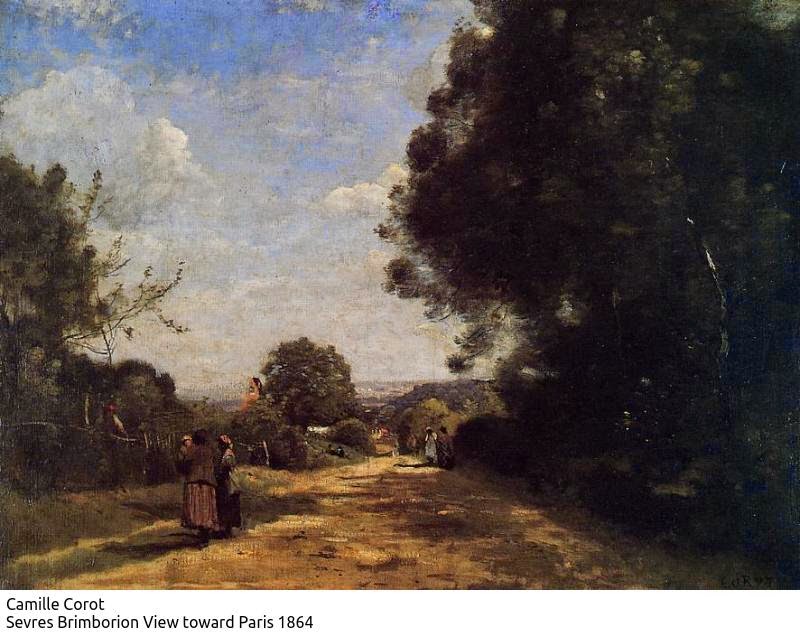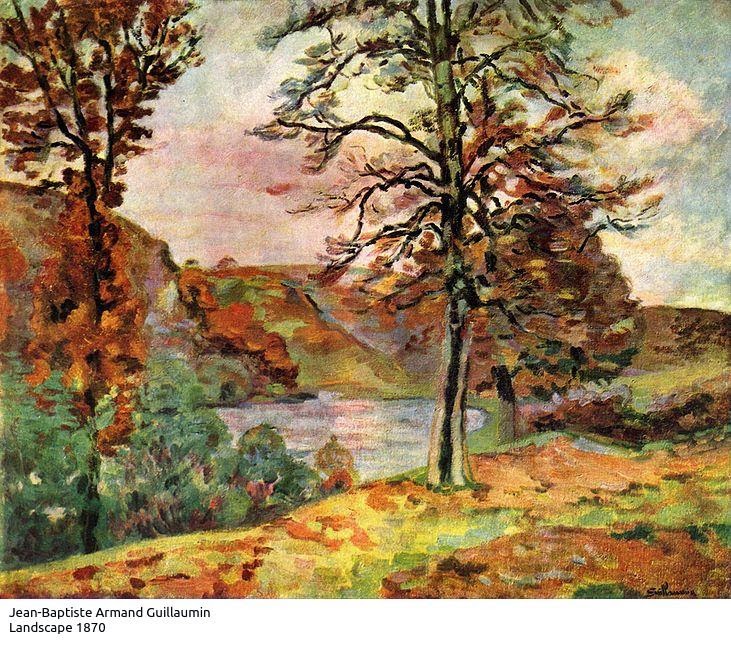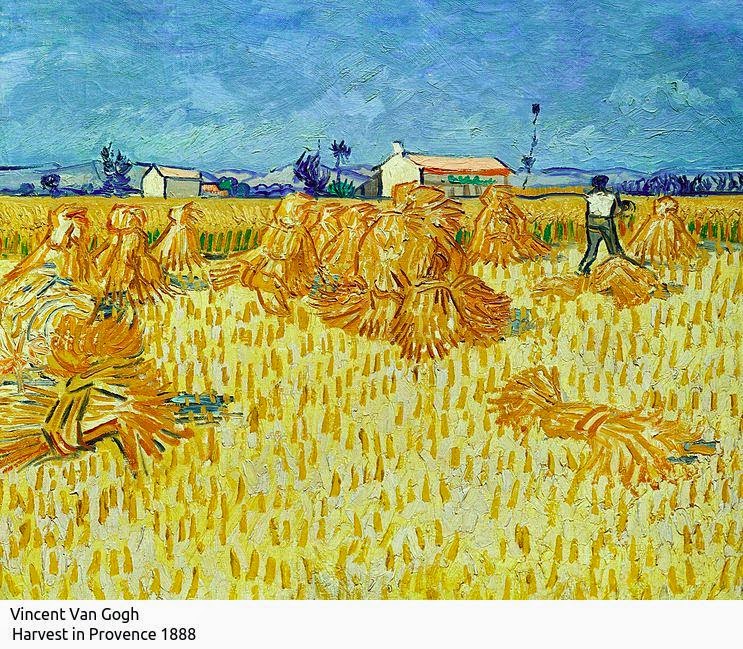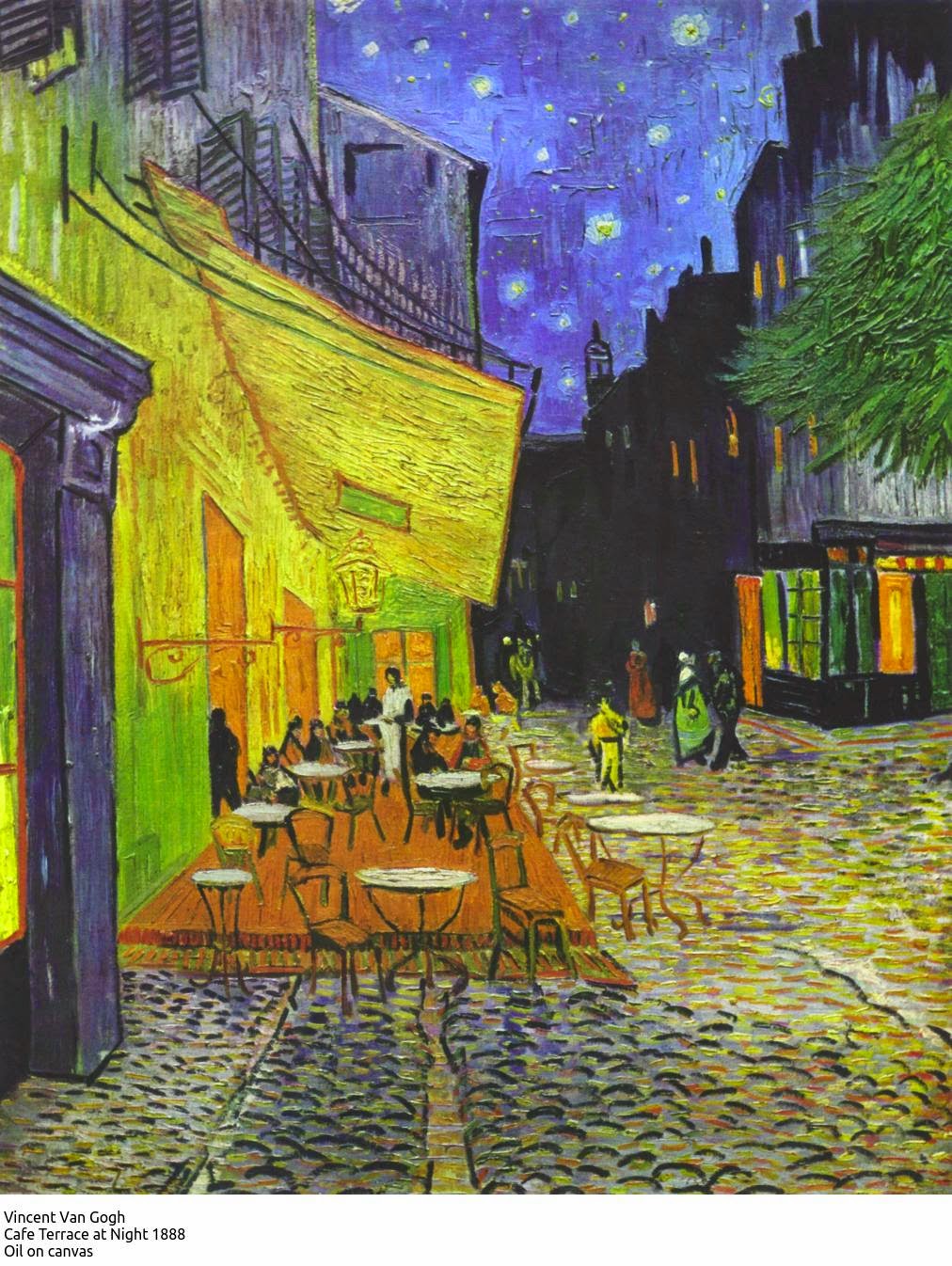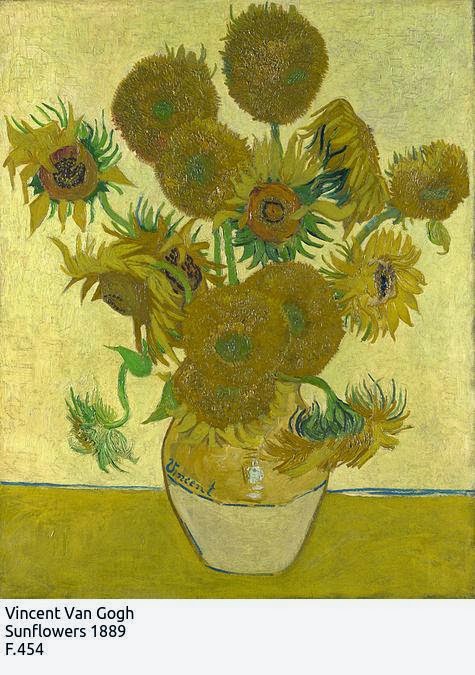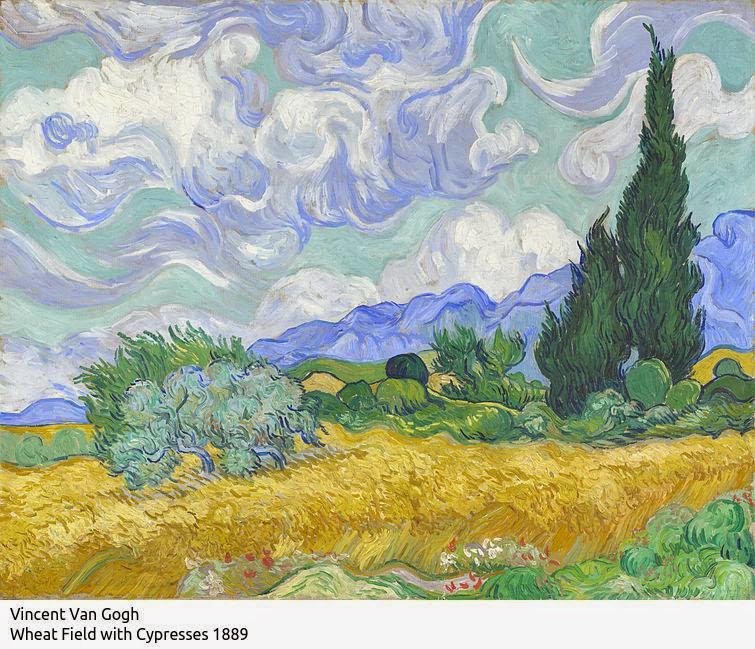Lecture Notes on Impressionism
Impressionism is a movement in art which began in France in about 1863 and created a style of art that is still practised today.The name “Impressionism” seems to have been coined in 1874 and came from a critique of Claude Monet's painting called “Impression, Sunrise” by the humourist Louis Leroy in a review in the newspaper Le Charivari:
“Impression—I was certain of it. I was just telling myself that, since I was impressed, there had to be some impression in it ... and what freedom, what ease of workmanship! Wallpaper in its embryonic state is more finished than that seascape.”
The Impressionist Movement
A movement in art requires a style, a group of adherents to popularise the style and collectors to buy it.
In the case of Impressionism the adherents arose as a group of discontented artists during the dictatorship of Napoleon III in France. The style had two sources: a group of landscape painters working in the countryside near Paris and a group of seascape painters working in Le Havre.
However, before discussing the style of impressionism it is useful to understand French history in the years from 1815 to 1863.
------------------------------------------------------------------------------------------------------------
Potted history of France 1815-63
1815 Napoleon exiled to St Helena, Bourbon Monarchy restored. Louis XVIII was the supreme head of the state.
1830 Constitutional Monarchy under Louis Philippe I
1848 February Revolution. Second Republic. Louis Napoleon Bonaparte (Napoleon's nephew and heir) elected president.
1851 Louis Napoleon became dictator of France after a coup. He took the title Emperor Napoleon III. (Napoleon II never ruled France). France was governed as a dictatorship with an advisory, vaguely freely elected parliament.
1863-1869 In 1869 only 25% of French army recruits could read and write. 15000 schools were founded between 1863 and 1869 to educate the populace and universities expanded.
1863 Imperial decree that the Emperor appoint the Director of École des Beaux-Arts, seizing control from the Académie des Beaux-Arts – the elitist organisation of professional French painters.
-----------------------------------------------------------------------------------------------------------------------
 |
| Napoleon III |
The jury for the Salon of 1863 rejected two thirds of the submissions and there was an outcry from the rejected artists. The political nature of the Jury meant that Napoleon III became involved and to defuse the situation he proposed a special Salon for the rejected artworks, the official statement read:
"Numerous complaints have come to the Emperor on the subject of the works of art which were refused by the jury of the Exposition. His Majesty, wishing to let the public judge the legitimacy of these complaints, has decided that the works of art which were refused should be displayed in another part of the Palace of Industry."
This Salon became known as the Salon des Refusés.
Important works at the Salon des Refuses were:
Dejeuner sur l'herbe by Edouard Manet
 |
| Click on images to view larger pictures |
and Whistler's Symphony in white no.1: the white girl. Which might have been called Whistler's Mistress. At this time Whistler was widely regarded as a Pre-Raphaelite painter.
The birth of Impressionism
In 1862 Claude Monet, Auguste Renoir, Alfred Sisley and Frederic Bazille were
all students at the studio of Gabriel Charles Gleyre. Gleyre's style was academic, focussing on naked people, especially women, in various poses and not at all Impressionist. However, his studio brought these budding Impressionists together. It was probably the wealthy young artist, Frederic Bazille, who was most important in bringing the Gleyre group close together, sharing his lodgings with Monet, Renoir and Sisley and even buying them artist's materials and buying their pictures.
Another important meeting place for the young impressionists-to-be was the Academie Suisse, an alternative art college founded by Charles Suisse. Students of the Academie Suisse included:
Paul Cézanne (1839–1906)
Édouard Manet (1832–1883)
Claude Monet (1840–1926)
Camille Pissarro (1830–1903)
and formed the social connection between Manet, Cezanne and Pissaro and Gleyre's group.
Edgar Degas is the odd-man-out of the original Impressionists. He went to the Ecole des Beaux-Arts and regularly exhibited at the Salon. He could turn his hand to the sex and violence needed to be picked by the Jury.
He met Manet in 1862. Degas and Manet were both from fairly wealthy families and the two became firm friends in the later 1860s. In 1868 Manet began to host meetings of young painters, the Batignolles Group, at the Cafe Guerbois. The meetings brought together the artists: Frédéric Bazille, Henri Fantin-Latour, Edgar Degas, Claude Monet, Pierre-Auguste Renoir, Alfred Sisley, Paul Cézanne and Camille Pissarro. Of this group Fantin-Latour never became an Impressionist and Degas and Fantin-Latour were accepted by the regular Salon. The prominent writers: Émile Zola and Louis Edmond Duranty also attended the meetings.
The Impressionists were a social grouping that originated in Gleyre's studio and became firmly linked through cafe society and especially the patronage of Manet and Bazille.
The group were not Impressionists at first but developed the style during the 1860s. Although Monet and Pissaro were already primed in the Impressionist style before they had gone to Paris.
Camille Pissarro (1830-1903) was the oldest of the Impressionists and had grown up in the Danish West Indies (now the US Virgin Islands) and his painting from this time shows distinct features of Impressionism before Impressionism was invented.
Claude Monet (1840-1926) was also painting in a fresh, open air style in the late 1850s:
The most important influences on the Impressionist style occurred in the 1860s and were the seascape painters of Le Havre and the Landscape painters, the Barbizon School, who worked near Barbizon, a country town east of Paris that is on the edge of the Fontainebleau forest.
There were two important seascape painters who influenced Monet in the early 1860s. These were Eugene Boudin, who ran an art shop in Le Havre and another mad, but brilliant, Dutchman, Johan Jongkind, who visited Le Havre at this time. Monet, Boudin and Jongkind would go out painting together.
But Monet outdoes both of these painters:
The other major influence on the Impressionists was the Barbizon School. The Barbizon School were dedicated to painting nature for its own sake, not simply as a backdrop to mythological or moral themes. They also painted studies “en plein-air”, outside and directly from nature although they generally finished their work in the studio.
The leading lights of the Barbizon School were Jean-Baptiste-Camille Corot, Théodore Rousseau, Jean-François Millet, and Charles-François Daubigny. The impressionist who was most influenced by the Barbizon School was Pissarro who was a pupil of Corot . A typical Corot of the early 1860s is shown below:
This Barbizon influence is very evident in Pissarro's work in the 1860s.
However, it is Pierre Auguste Renoir (1841-1919) who is, in the public imagination, and perhaps stylistically, the archetypical impressionist. Unlike Manet and Degas who were upper middle class, and Monet and Pissarro, who were well heeled, Renoir came from a poor working class family. He started painting at the Levy Brothers porcelain factory (from 1854-58) and this is evident in some of his earliest work:
Renoir went to Gleyre's Studio with Monet, Sisley and Bazille which freed his style from the porcelain image. However, he was an exceptionally accomplished artist from the start.
Frederic Bazille (1841-1870) may have been the first of the group to produce an Impressionist work of art.
Although one of the youngest of Gleyre's students Bazille was the typical French Gentleman of the period. He was as wealthy as Manet and Degas, highly intelligent, having switched from medicine to art and gave the whole group an air of respectability. The Landscape at Chailly shows almost all the features that were to become the Impressionist Style. It is painted en pleine air, the brush strokes are bold and colour is the essence of the work, especially the complementary red-green areas across the centre of the picture.
So far we have talked about Monet, Pissarro, Bazille and Renoir. These artists were central to the bright, light style of Impressionism that became popular in the later 1870s. They were stylistically ahead of Manet and Degas although Manet and Degas had the cash to host the cafe meals.
Something happened in the late 1860s that caused all of the artists who became the Impressionists to adopt a similar style. Some sort of zeitgeist spread through them all. Their palettes lightened yet further and they started to boldly deliver impressions of the everyday world. Perhaps it was because Monet, Renoir and Sisley all moved into Bazille's apartment in 1866-1867. This collaborative atmosphere bore fruit over the next two years.
The change can be clearly seen in Claude Monet's art, in 1867 we have an almost mature “Monet”:
Renoir also matures by 1867:
And again, Pissarro is awash with colour:
Even Manet catches the bug:
As does Berthe Morisot, who had joined the group. Berthe Morisot studied as a pupil of Corot's from 1861. She was very much a part of the Impressionist movement and inevitably ended up marrying Manet's brother.
Someone seems to have said “Let there be light!”
But why did this happen in 1866-67?
There is a telling portrait in 1870 by Henri Fantin Latour, an academic artist who was a friend of the Impressionists.
The painting was caricatured at the time by a cartoonist in the Journal Amusant under the title “Jesus Painting Among His Disciples”. Manet is the centre of the group. Emile Zola, a popular journalist and novelist, was especially keen on Manet's “naturalistic” style of painting and wrote in his column in the newspaper “L'Evenement” in 1866 that “M Manet's place in the Louvre is marked out”. However, although Manet became the social focus of the Impressionists he did not begin to host meetings of the Batignolles Group at the Cafe Guerbois until 1868 and the style of Impressionism seems to have been born in about 1866.
Pissarro, Renoir, Sisley, Bazille and Monet were working and/or living closely together in 1866-7. In 1867, having been refused by the Salon yet again, all of this group except Monet started a petition for a new “Salon de Refuses” but official backing was refused and they did not have the funds to mount their own exhibition.
It seems that the Impressionist style was born out of close contact between a group of artists, especially Pissarro, Renoir, Sisley and Bazille and was expanded and popularised as a result of patronage by Zola and Manet. Although Impressionism was born in about 1866 it was known as “realism” or “naturalism” and firmly included Manet's earlier art. It was only after 1874 that the name “Impressionism” was coined and it was only used by the Impressionists to describe their own work from 1877 onwards. Manet's style can be seen as Naturalistic but frequently not Impressionist.
The Impressionists brought the light but then the darkness fell across France.
1870 was a year of turmoil and change in France and without understanding this change it is a mystery as to why the art buying public would support this revolutionary new style of art.
In 1870 France declared war on Prussia. Both sides wanted war for their own reasons. On September 2nd Napoleon III surrendered at the Battle of Sedan. However, France did not surrender and a Republican Government of National Defence was formed and the war continued.
In 1871 Paris was starving and bombarded by Prussian artillery. An Armistice was signed on 26th January 1871 and Napoleon III was exiled to Britain. On 17th February Adolfe Thiers was elected president of the Third Republic.
In 1871 the Paris Commune was declared and lasted from 18th March – 28th May. It was suppressed by troops of the Third Republic with perhaps 10,000 Parisians killed. The Commune followed the pattern of most revolutions: overthrow of tyrant, government of liberals, bid for power by demagogues. In England: Charles I, Rump Parliament, Cromwell. In France Louis XVI, the Directory, Napoleon or in 1848, Louis Philippe, Second Republic, Napoleon III . In Russia: Tsar Nicholas II, Kerensky, Bolsheviks. Except that this time the demagogues of the Commune lost and the Third Republic continued.
From 1871 to 1883 there was continuous debate about restoration of the absolute monarchy and the powers of the president. In 1875 the Constitutional Laws of the New Republic were passed which enshrined an elected president. In Le Seize Mai “coup” in May 1877 the monarchist president Patrice de Mac-Mahon dissolved parliament and called an election in October in which he was soundly defeated. In 1883, the childless Comte de Chambord, heir to the throne, died and monarchism faded.
The only Impressionist who fought on the front line in the Franco-Prussian war was Frederic Bazille. He joined a Zouave regiment and died heroically at the battle of Beaune La Roland at the age of 28.
At the outbreak of war Monet slipped away to England and subsequently Holland, Sisley had English citizenship but stayed in Paris, Whistler was an American citizen and retired to London, Pissarro went with his family to London, Renoir got a post training horses in the Pyrenees, Degas joined the National Guard in Paris and Manet waited to be conscripted into the National Guard, serving in Paris.
Bazille's paintings were striking:
If a little homoerotic at times...
But this was the last that would be seen of Bazille's skill.
Whilst in exile Pissarro and Monet produced some paintings that are of interest to an English audience.
The Realist Exhibition of 1874.
In 1874 Degas, Renoir, Pissarro, Morisot, Monet and many more of those who were painting in the new “realist” or “naturalistic” style banded together to form the “Anonymous Society of Painters, Sculptors, Engravers, etc.” which in English translates to: “Painters, Sculptors, Engravers, etc. Ltd”. Limited Liability Corporations were the latest thing in 1870.
Thirty artists displayed 165 works at the the modern building that was the photographer Nadar's former studio at 35 Boulevard des Capucines. Degas was the principle organiser and Manet did not exhibit.
Exhibitors:
Zacharie Astruc
Antoine-Ferdinand Attendu
Édouard Béliard
Eugène Boudin
Félix Braquemond
Édouard Brandon
Pierre-Isidore Bureau
Adolphe-Félix Cals
Paul Cézanne
Gustave Colin
Louis Debras
Edgar Degas
Jean-Baptiste Armand Guillaumin
Louis LaTouche
Ludovic-Napoléon Lepic
Stanislas Lepine
Jean-Baptiste-Léopold Levert
Alfred Meyer
Auguste De Molins
Claude Monet
Mademoiselle Berthe Morisot
Mulot-Durivage
Joseph DeNittis
Auguste-Louis-Marie Ottin
Léon-Auguste Ottin
Camille Pissarro
Pierre-Auguste Renoir
Stanislas-Henri Rouart
Léopold Robert
Alfred Sisley
There were many newcomers, artists who had adopted the Impressionist approach, who exhibited at the 1874 Exhibition:
Zacharie Astruc was a critic and sculptor but tried his hand at painting.
Jean-Baptiste Armand Guillaumin had been part of the circle of friends since the 1860s.
Probably the most impressive painting in the Exhibition was Renoir's
Unfortunately for the Impressionists there were also artists who we now know as Post-Impressionists exhibiting and these were certainly too different for the public or critics to accept.
Cezanne's work is no impression, it is a re-creation of nature according to the artist's ideals.
The 1874 Exhibition was a critical disaster. The most famous of the criticisms came from the critic Louis Leroy:
Manet may not have exhibited in 1874 but his art had taken on the Impressionist style:
Onwards and Upwards
The most important aspect of the 1874 exhibition was the large number of artists who had adopted the new “Naturalist” style. Impressionism had become an art for artists and the buying public just needed to learn how to appreciate it.
Despite the poor reviews for the 1874 Exhibition, the Impressionist Exhibitions became a fixture on the Paris art scene and there were eight exhibitions in total between 1874 and 1886 (74,76,77,79,80,81,82,86).
In 1875 the leading Impressionists held a public auction of their work and could scarcely give away their paintings.
The second, 1876 Exhibition was another critical failure. There were fewer artists (19) contributing but these included a lot of new names as well as the old faithfuls:
Édouard Béliard
Pierre-Isidore Bureau
Gustave Caillebotte
Félix-Adolphe Cals
Edgar Degas
Marcellin Desboutin
Jacques François (an anonymous woman)
Alphonse Legros
Jean-Baptiste-Léopold Levert
Ludovic-Napoléon Lepic
Jean-Baptiste Millet (Jean-François Millet's brother)
Claude Monet
Berthe Morisot
Léon-Auguste Ottin fils
Camille Pissarro
Pierre-Auguste Renoir
Stanislas-Henri Rouart
Alfred Sisley
Charles Tillot
Manet did not exhibit and was stll trying to get accepted by the Salon.
The most notable new contributor was Gustave Caillebotte. Gustave Caillebotte was not only an artist but also a wealthy art collector.
Caillebotte organised the third Exhibition in 1877 and for the first time, used their new name, calling the exhibition the “Exhibition of Impressionists”. No-one was allowed to contribute unless they foreswore ever exhibiting at the Salon.
The Fourth Exhibition was held in 1879 and the Impressionists changed their name to “The Independent Artists”. This Fourth Exhibition actually made a profit and was seen by 15,400 visitors compared with 4000 for the first exhibition.
The solidarity of the Independent Artists fractured when first Renoir, in 1879, and then Monet in 1880, submitted work to the Salon. Degas was mortified and refused to speak to Monet. Manet was also now getting his work accepted by the Salon.
It was not until the Seventh Exhibition of the Independent Artists in 1882 that there was some critical acclaim for the Impressionists. This may have been because it involved fewer contributors who exhibited some of their finest work. The contributors were:
Gustave Caillebotte
Paul Gauguin
Armand Guillaumin
Claude Monet
Pierre-Auguste Renoir
Alfred Sisley
Mme. Berthe Morisot
Camille Pissarro
Victor Vignon
It was also the case that Impressionism had become popular with collectors outside of France. This popularity was largely due to the American Impressionist artist Mary Cassat who was exhibited in the Pennsylvania Academy in Philadelphia in 1876, 1878 and 1879. In France in the late 1870s Cassat introduced the collectors Mrs Havermeyer, Mrs Potter Palmer and James Stillman to Impressionism and Cassat also collected many paintings herself, especially those by her teacher, Edgar Degas.
Cassat's brother, Alexander Cassat was President of the Pennsylvania Railroad System and loaded. Mary Cassat sent hime pictures by Pissarro, Monet and Degas.
Mary wrote to her brother that: “When you get these pictures you will probably be the only person in Philadelphia who owns specimens of either of the Masters. Mame's friends, the Elders, have a Degas and a Pissarro and Mame thinks that there are no others in America”.
John G Johnson, Supreme Court judge was extremely wealthy and one of the most avid art collectors in the Philadelphia area. He noticed the new Impressionist paintings and started to buy his own.
In 1886 the American Art Association put on a major exhibition in New York of paintings by the principle Impressionists (supplied by the art dealer Paul Durand Ruel). The American collectors bought 15 of the pictures for $17,000. He wrote to the artist Fantin-Latour saying:
“Don't think that the Americans are savages..on the contrary, they are less ignorant, less bound by routine, than our French collectors.”
A small group of wealthy New York art collectors began to focus on Impressionists, especially James F Sutton of the American Art Association. After the late 1880s every US Industrialist and billionaire who had an art collection started buying Impressionists and their place in history was assured.
(See American Collectors of French Impressionist Art by Amy Linda Boyce https://archive.org/stream/americancollecto02boyc#page/n5/mode/2up )
By the time of the eighth, and last Exhibition in 1886 Impressionism was no longer “leading” edge and the exhibition included works by neo-impressionists such as Georges Seurat and Paul Signac and by post-impressionists such as Gauguin.
Famous Impressionist Pictures
The Legacy of Impressionism
Impressionism opened up the possibility of experimentation in art. It changed painting from a representation of visual space to embrace the representation of the psychological and imaginary.
This licence to experiment opened the floodgates to a whole succession of new styles and approaches in the late 19th and early twentieth century.
The Impressionist Style
The style of Impressionism introduced light into the dark, studio art or the nineteenth century. Impressionism used ordinary subjects and everyday scenes and, most importantly, Impressionist painting often resembles a snapshot, a part of a larger reality captured as if by chance. Although the painting was a “snapshot” it was supposed to embody the sentiment and emotion of the artist so that it transcended photography.
There is an excellent summary of the Impressionist technique in Wikipedia:
Short, thick strokes of paint quickly capture the essence of the subject, rather than its details. The paint is often applied impasto (thickly and with texture).
Colours are applied side-by-side with as little mixing as possible, creating a vibrant surface. The optical mixing of colours occurs in the eye of the viewer.
Grays and dark tones are produced by mixing complementary colours. Pure impressionism avoids the use of black paint.
Wet paint is placed into wet paint without waiting for successive applications to dry, producing softer edges and intermingling of colour.
Painters often worked in the evening to produce effets de soir—the shadowy effects of evening or twilight.
Impressionist paintings do not exploit the transparency of thin paint films (glazes), which earlier artists manipulated carefully to produce effects. The impressionist painting surface is typically opaque.
The play of natural light is emphasized. Close attention is paid to the reflection of colours from object to object.
In paintings made outdoors, shadows are boldly painted with the blue of the sky as it is reflected onto surfaces, giving a sense of freshness previously not represented in painting. (Blue shadows on snow inspired the technique.)









